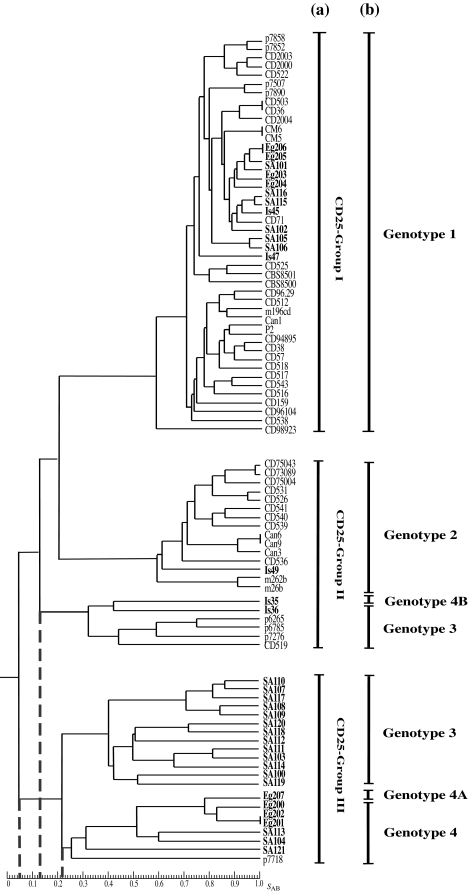FIG.2.
Dendrogram generated from the SABs computed for every possible pairwise combination of independent C. dubliniensis isolates from Saudi Arabia and Egypt (n = 30), Israel (n = 5), and 13 other countries (n = 51) from the study of Gee et al. (18) fingerprinted with Cd25. At an SAB node of 0.05 (short dashed vertical line), the isolates are divided into three main populations, the first and second of which correspond to the major clades Cd25 group I and Cd25 group II described previously (18, 22). The third main population (Cd25 group III) corresponds to a third major clade identified in this study and contains 20/30 of the Saudi Arabian and Egyptian isolates investigated. The Cd25 group I major clade consists solely of closely related genotype 1 isolates with an average SAB value of 0.63 ± 0.12. At an SAB node of 0.13 (short dashed vertical line), the Cd25 group II major clade can be divided into two minor clades, the first of which consists solely of genotype 2 isolates. The second minor clade consists of genotype 3 isolates and the genotype 4B variant isolate Is35. At an SAB node of 0.22 (short dashed vertical line), the Cd25 group III major clade can also be divided into two minor clades, the first of which consists solely of genotype 3 isolates and the second solely of genotype 4 isolates, including the genotype 4A variant isolate Eg207. Within the Cd25 group III major clade, all of the isolates were from Saudi Arabia or Egypt and were resistant to 5FC (MIC50 ≥ 128 μg/ml), apart from the Israeli isolate, p7718 (18), which was susceptible to 5FC (MIC50 ≤ 0.125 μg/ml). All of the other Saudi Arabian, Egyptian, and Israeli isolates investigated in this study and a selection of 24 independent isolates from the study of Gee et al. (18) (10 Cd25 group I isolates and 14 Cd25 group II isolates) were susceptible to 5FC (MIC50 ≤ 0.125 μg/ml). The Saudi Arabian, Egyptian, and Israeli isolates investigated in this study are highlighted in boldface. The Cd25 groups (a) and the ITS genotypes (b) of the isolates are shown to the right of the dendrogram.

